
Discussão sobre o tema da descentralização de dados e a importância de ter uma estratégia e uma tecnologia para apoiá-la.

Discussão sobre o tema da descentralização de dados e a importância de ter uma estratégia e uma tecnologia para apoiá-la.

Há muitos benefícios financeiros na integração corporativa e no uso do iPaaS corporativo da Digibee, como a economia de custos ao permitir que desenvolvedores juniores sejam utilizados. Mas, além disso, há ganhos financeiros significativos a serem obtidos com a velocidade, especialmente os benefícios de uma receita mais rápida, graças a um ciclo de lançamento de produtos acelerado.
Um estudo recente conduzido pela Forrester, Total Economic Impact™ of Digibee Report forneceu uma análise independente que explorou sistematicamente os resultados de uma parceria com a Digibee para integração corporativa. Usando uma organização composta, modelada com base nas características das empresas entrevistadas, o relatório atribuiu mais de US$ 1.3 milhão dos US$ 5.9 milhões de benefícios totais em Valor Presente (PV) à capacidade de acelerar o tempo de lançamento de novos produtos e serviços — isso representa mais de um quinto dos benefícios financeiros totais!

Os sistemas de informação do varejo devem funcionar como um elo entre o mundo digital e o físico, um verdadeiro desafio quando ambos estão em constante mudança de maneiras diferentes.
De um lado, os clientes esperam uma rápida e fácil experiência omnichannel personalizada diretamente do conforto de seus sofás. Do outro, suas soluções de TI para o varejo precisam não apenas atender a essas expectativas, mas também garantir a entrega ágil e perfeita dos produtos físicos adquiridos, mesmo que sejam 200 quilos de mármore italiano para uma bancada de cozinha.
Cada produto físico requer matérias-primas, fabricação e, no mínimo, envio ao usuário final. Como esses custos são inevitáveis, lidar com excesso de estoque pode rapidamente se tornar uma despesa significativa.
Por outro lado, como o processo de fabricação geralmente leva mais tempo do que o cliente estaria disposto a esperar, na maioria dos casos ele precisa ser concluído antes mesmo de um pedido ser feito. Isso coloca o varejista em uma posição desafiadora, na qual corre o risco de ter estoque demais ou de menos. Nesse contexto, a previsão precisa de demanda no varejo é essencial para proteger sua margem de lucro.
>> Agende uma demonstração personalizada com nossa equipe de especialistas e veja como o iPaaS da Digibee trará eficiência ao seu negócio.
Análise de dados é um tema quente para a tecnologia no varejo. Embora sua evolução nos últimos anos seja impressionante, o conceito central continua o mesmo: utilizar os dados coletados e analisá-los para tomar melhores decisões de negócios. Em sua forma mais simples, a prática tem sido empregada manualmente por empresas de varejo há centenas, senão milhares, de anos, ajudando a aliviar o problema de estimar quanto novo estoque comprar.

Até recentemente, analisar os dados de sua empresa para previsão de demanda no varejo era um processo bastante manual, envolvendo alguém habilidoso no Excel tentando identificar padrões em quem comprava o quê e quando (ou, antes disso, revisando os livros contábeis manualmente!).
Hoje, as soluções de análise de dados para o setor varejista não apenas envolvem cálculos estatísticos, mas também o uso de linguagens de programação como Python, R e SQL, ferramentas de visualização de dados e até algoritmos de aprendizado de máquina e inteligência artificial.
Com essas ferramentas, a análise de dados integrada pode sintetizar informações de conjuntos de dados maiores e mais complexos do que era possível anteriormente, além de encurtar drasticamente o ciclo de feedback. Assim, as empresas podem rapidamente avaliar o impacto de suas decisões de merchandising e ajustá-las conforme necessário.
Os clientes buscam uma experiência omnichannel personalizada e empresas que se alinhem com seus valores, como sustentabilidade ambiental, segundo o relatório Top Trends in Retail Digital Transformation and Innovation for 2022da Gartner. A integração da análise de dados pode atender a ambas as expectativas dos clientes, ao mesmo tempo que melhora a previsão de estoques graças a uma maior compreensão do comportamento do consumidor.
“Domínios tradicionalmente ‘intocáveis’, como merchandising, estão percebendo que precisam passar por uma mudança tectônica única em direção à construção de uma base sólida nos modelos de hierarquia de comportamento do cliente, em vez de hierarquias de produtos.”
Gartner Top Trends in Retail Digital Transformation and Innovation for 2022
A previsão de demanda no varejo consiste em usar dados para prever a demanda futura de clientes por um produto ou serviço. Analisando grandes volumes de dados, os varejistas podem obter insights valiosos sobre os hábitos de compra de seus clientes e usá-los como base para futuros pedidos de produtos.
Algoritmos de aprendizado de máquina são especialmente eficazes nesse processo, pois podem ser treinados em grandes conjuntos de dados históricos para identificar microtendências ou correlações entre fontes de dados distintas. Eles também têm sido usados de maneira inovadora para reduzir o desperdício, como na aplicação de preços dinâmicos em supermercados com base em datas de vencimento próximas.
A qualidade e a quantidade de dados disponíveis para análise são os principais fatores que limitam os insights empresariais que a análise de dados pode oferecer. Em geral, as empresas mantêm um conjunto complexo de soluções tecnológicas para o varejo, como e-commerce, sistemas de ponto de venda (POS) e gestão de estoques, que geram e armazenam dados de clientes e produtos.
Com tantas soluções de TI no varejo, é comum que se formem silos que criam barreiras ao acesso pleno às informações disponíveis. Quando isso ocorre, a precisão dos resultados analíticos é prejudicada. Se apenas um aspecto do comportamento de compra do cliente for capturado, correlações importantes podem ser perdidas – ou mal interpretadas –, levando a uma visão distorcida do que motivou as decisões do cliente.
A integração empresarial desempenha um papel essencial na melhoria da análise de dados, garantindo que os dados de todos os sistemas de informação do varejo dentro de uma organização sejam acessíveis, consistentes e confiáveis.
Isso amplia o leque de fontes de onde os dados analíticos podem ser coletados, proporcionando uma visão mais precisa e abrangente dos comportamentos e tendências de compra dos clientes. Além disso, o tempo reduzido de lançamento de novos produtos e serviços proporcionado pela integração empresarial (EI) também beneficia a análise de dados. Fontes externas, como novos canais de mídia social ou pesquisas de mercado, podem ser rapidamente integradas, oferecendo insights atualizados e valiosos.
Para aproveitar ao máximo a integração de análise de dados no varejo, conte com a Digibee. Com experiência prática auxiliando varejistas como a Payless a integrar os sistemas de informação de mais de 200 lojas em 15 países, entendemos exatamente o que você precisa para oferecer suporte aos seus clientes, onde quer que estejam.
Sabemos que fechar a loja para atualizações não é uma opção para o varejo. Por isso, oferecemos soluções flexíveis de integração que permitem operar seus sistemas legados em paralelo com a nova plataforma. Assim, garantimos a continuidade operacional do seu negócio e uma experiência sem interrupções para o cliente.
Saiba mais sobre como o e-commerce totalmente integrado com Digibee pode eliminar as suposições da previsão de demanda, our agende uma demonstração para ver nossa solução em ação.
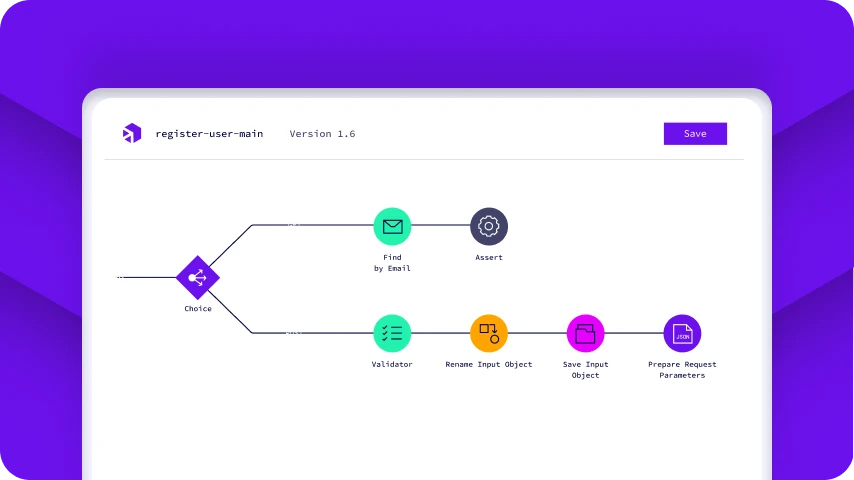
A tecnologia desatualizada está atrasando seus esforços de transformação digital? Você provavelmente já ouviu falar que as soluções de integração podem ajudar a modernizar a arquitetura legada, mas qual é a certa para você e como você pode minimizar os custos de integração e as interrupções nas suas operações? Nesta postagem, exploraremos as cápsulas de integração reutilizáveis e como a Digibee as utiliza para tornar a integração simples e eficiente.
Muitas organizações estão migrando para a integração de sistemas de TI como forma de modernizar sua empresa, acelerar a transformação digital, melhorar os processos de negócios e obter melhores resultados em suas estratégias.
De acordo com o eBook da Digibee Relatório State of Enterprise Integration de 2022 da Digibee, 93% dos entrevistados dizem que a integração empresarial deve fazer parte de sua estratégia de negócios. Noutro Recurso Digibee sobre estratégia de integração, o Gartner afirma que, até 2025, mais de 75% das organizações de médio, grande porte e globais estabelecerão equipes de capacitação de estratégias de integração para apoiar a integração colaborativa.
No entanto, à medida que mais empresas seguem o caminho da integração empresarial, os líderes de negócios percebem rapidamente a complexidade do empreendimento. Sejamos realistas: construir uma solução de integração do zero é um grande compromisso.
>> Agende uma demonstração personalizada com nossa equipe de especialistas e veja como o iPaaS da Digibee trará eficiência ao seu negócio.
As integrações de sistemas de TI podem levar muito tempo, recursos, conjuntos de habilidades específicas, treinamento, certificação e talvez a maior consideração: orçamento. No relatório Digibee, 36% dos profissionais de TI corporativos classificam o orçamento como a maior preocupação ao considerar uma estratégia de integração. Há também várias outras preocupações que os líderes de negócios temem que possam impedir suas estratégias de integração, incluindo segurança, complexidade, falta de habilidades e complicações de sistemas legados.
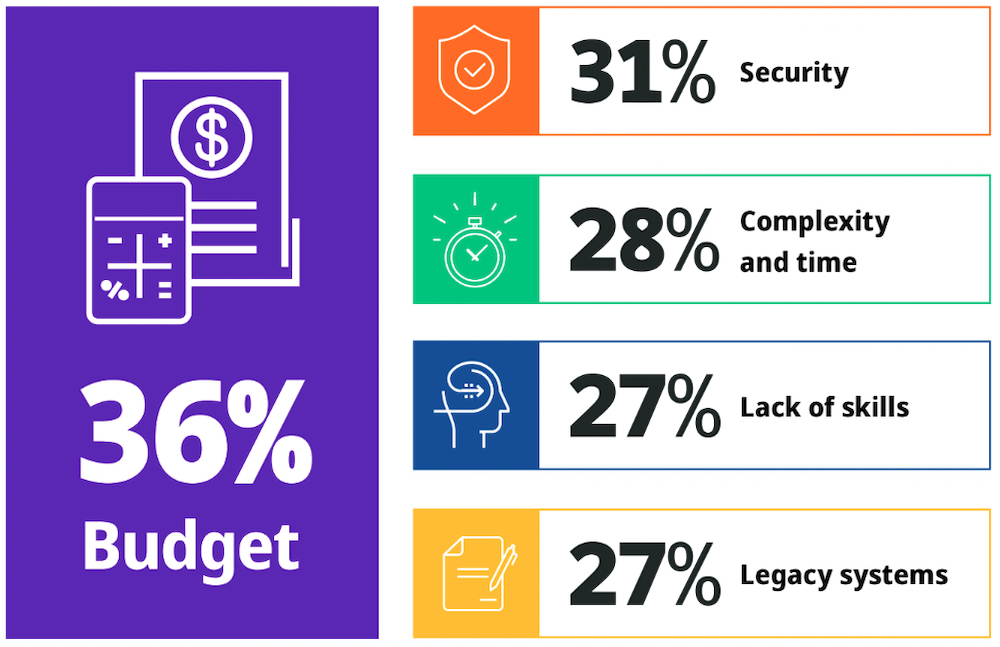 Fonte: O relatório State of Enterprise Integration da Digibee 2022.
Fonte: O relatório State of Enterprise Integration da Digibee 2022.
Um projeto de integração pode abranger uma variedade de diferentes protocolos e tecnologias. Isso pode incluir software de planejamento de recursos empresariais (ERP), sistemas de gerenciamento de relacionamento com clientes (CRM), mainframes, serviços em nuvem, bancos de dados relacionais e não relacionais, bem como uma série de outras considerações. Dependendo do nível de maturidade técnica da sua empresa, o uso de uma interface de programação de aplicativos (API) externa também pode causar atritos e dificuldades adicionais durante o processo de integração. Além disso, a maioria das empresas que criam soluções de integração do zero deve reconstruir continuamente projetos de integração únicos para manter o crescimento dos negócios.
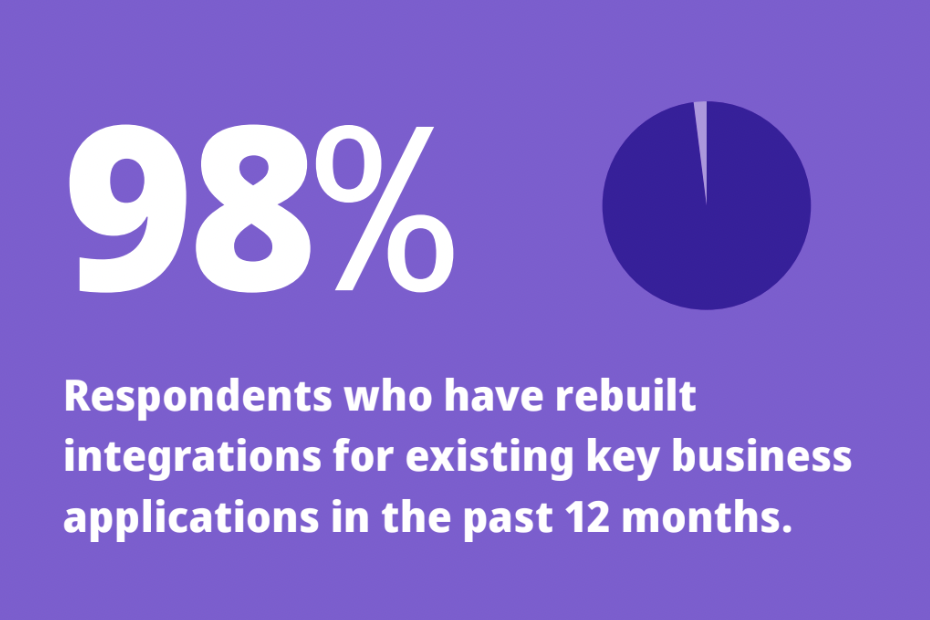
Número de integrações que tiveram que ser reconstruídas:
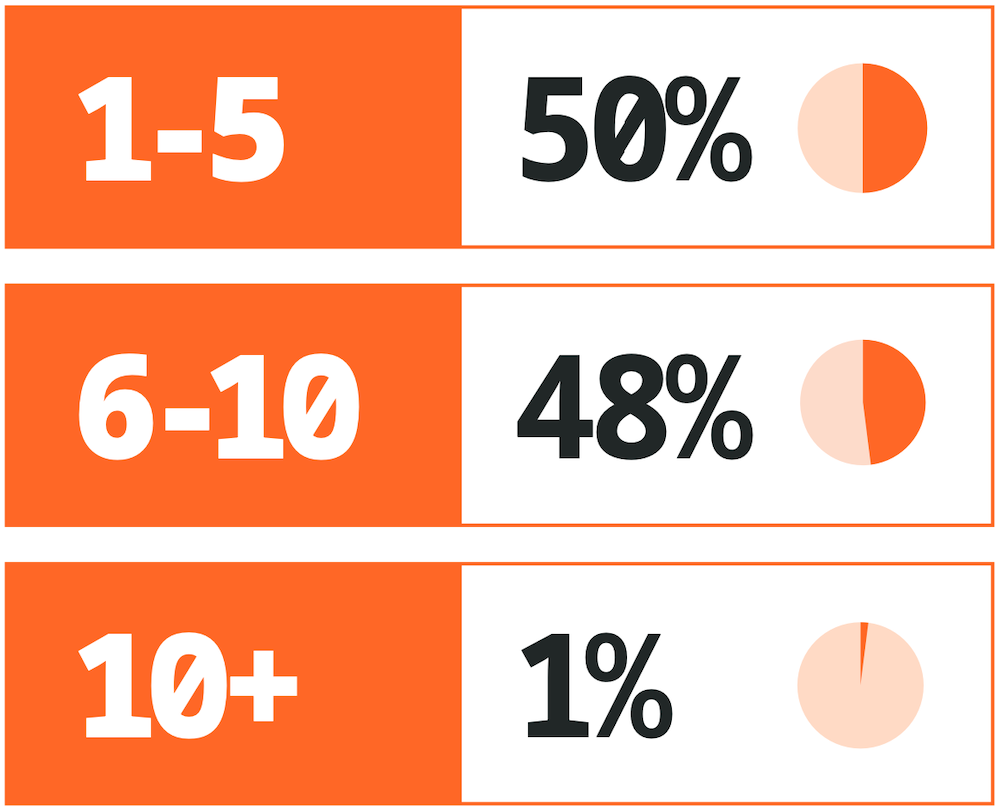 Fonte: O relatório State of Enterprise Integration da Digibee 2022.
Fonte: O relatório State of Enterprise Integration da Digibee 2022.
Com todas essas complicações, você pode estar coçando a cabeça e se perguntando: o objetivo de uma estratégia de integração de TI não é tornar as coisas mais rápidas, simples e fáceis? A resposta é sim, e existe uma maneira de conseguir isso com a tecnologia da Digibee.
As Cápsulas Digibee são componentes reutilizáveis validados que podem ser criados por qualquer usuário da plataforma para economizar tempo, esforço e dinheiro com segurança durante a integração do sistema. Usar as Cápsulas da plataforma low-code da Digibee fornece uma lógica de negócios pré-empacotada, que evita a necessidade de reconstruir cada integração a partir do zero.
As cápsulas tornam mais fácil para você modernizar as operações de TI simplificando, padronizando e documentando suas interações com parceiros e clientes. As Cápsulas fornecem conjuntos de integração prontos para uso, testados e validados que podem ser reutilizados de várias maneiras interna e externamente.
Sua organização pode definir e documentar todos os parâmetros, fluxos de dados e processos de negócios dentro do contexto do seu projeto de integração porque as Capsules podem ser construídas por seus próprios desenvolvedores (ou pela Digibee, se isso for melhor para o seu negócio). As Capsules podem então ser usadas por vários parceiros ou clientes simultaneamente, sem permitir alterações que possam interromper todo o ecossistema, o que garante a qualidade e a segurança dos dados.
Uma solução corporativa de plataforma de integração como serviço (Enterprise iPaaS ou eiPaaS) é um serviço escalonável baseado em assinatura que preenche a lacuna entre seus sistemas atuais e novas tecnologias, independentemente dos silos subjacentes ou da infraestrutura legada.
De acordo com o Gartner, uma solução empresarial iPaaS pode fornecer vários cenários de integração de tecnologia com alta disponibilidade e funcionalidade eficiente. Portanto, é compreensível por que um número crescente de líderes de negócios está considerando uma solução eiPaaS em vez de continuar a criar – e reconstruir – soluções internas.
As Cápsulas Digibee podem ser usadas com o iPaaS low-code da Digibee para criar integrações seguras e escaláveis com desempenho confiável contínuo entre sistemas locais e baseados em nuvem. O iPaaS da Digibee permite dimensionar as operações de negócios usando a arquitetura existente e a tecnologia nativa da nuvem, aproveitando o Kubernetes para integrações eficientes.
O melhor de tudo é que as Cápsulas da Digibee são reutilizáveis, permitindo que desenvolvedores de todos os níveis aproveitem facilmente o trabalho que a equipe já realizou.
Por exemplo: uma Cápsula foi criada para oferecer suporte a uma integração entre seu CRM e seu SAP ERP, um sistema que deve se conectar a uma variedade de bancos de dados e pontos de dados. Em vez de reconstruir cada integração do zero, sua equipe de desenvolvedores pode reutilizar a Cápsula da Digibee para suportar todas essas integrações, economizando tempo e recursos significativos.
Para os cenários mais comuns, a Digibee já possui Cápsulas construídas que podem ser aplicadas como no cenário acima. E se você precisar fazer uma mudança nela por qualquer motivo, você faz isso uma vez e é aplicado a todos os pipelines do qual faz parte. Isso reduz substancialmente o tempo e a complexidade para sua equipe de desenvolvimento.
Ter a capacidade de reutilizaras Cápsulas da Digibee para componentes críticos de seus projetos de integração com o iPaaS ajudará a aliviar os pontos problemáticos de sua estratégia, simplificando a complexidade, garantindo a segurança dos dados, trabalhando com seus recursos atuais e conjuntos de habilidades dos funcionários e, em última análise, economizando tempo e dinheiro significativos para sua empresa.
Além de simplificar sua estratégia de integração empresarial, as Cápsulas da Digibee têm vários outros recursos que podem beneficiar sua empresa:
Reduza o tempo e o esforço de integração
Padronize os workflows de integração
Elimine a necessidade do portal do desenvolvedor
Melhore a segurança
Aumente a receita
Não deixe que a tecnologia desatualizada atrapalhe o seu negócio. Acelere a transformação digital e o sucesso da sua empresa com a ajuda das Cápsulas e da solução iPaaS escalável da Digibee. Nós podemos apoiar e acelerar de forma confiável sua estratégia de transformação digital e seu negócio à medida que ele cresce no futuro.
Para saber mais sobre as Cápsulas de integração reutilizáveis e ver como a Digibee os utiliza para ajudar você a integrar sem tempo de inatividade, agente agora uma demonstração. Traga-nos o projeto de integração que você não pode realizar até o próximo ano, mas precisa no próximo trimestre, e mostraremos a diferença da Digibee já na próxima semana.

A “Grande Demissão” acabou e com ela alguns dos desafios de contratação vistos nos últimos anos. Afastando-se dos confinamentos pandémicos e entrando na agitação económica global, que empregos continuam a ser quentes num mercado em arrefecimento?
Se as recessões estiverem sobre nós, veremos em breve o alto desemprego histórico visto em recessões anteriores e, portanto, uma rápida mudança em favor dos empregadores que anteriormente lutavam para encontrar talentos? Não exatamente. Forrester prevê que 80% das empresas direcionarão seus esforços de inovação para priorizar a resiliência, o que significa que, embora algumas funções possam agora ser menos competitivas ou até mesmo em risco, as funções que mais se alinham com as metas de resiliência permanecerão como empregos de tecnologia sob demanda em 2023.
Como é provável que a confiança de muitas empresas na tecnologia tenha aumentado nos últimos anos, devido à pandemia ou apenas como um estágio natural de desenvolvimento de negócios, permanecer resiliente envolve trabalhar com seus sistemas de tecnologia para garantir que eles sejam:
>> Agende uma demonstração personalizada com nossa equipe de especialistas e veja como o iPaaS da Digibee trará eficiência ao seu negócio.
Para manter seus sistemas funcionando, você precisa das habilidades de alguns desenvolvedores de software.
Grandes demissões em empresas como Salesforce, e rescindindo ofertas em Meta pode ter deixado a impressão de que os desafios de contratação de talentos de desenvolvimento de software ficaram para trás, mas é importante considerar que suas habilidades representam habilidades tecnológicas sob demanda na grande maioria das indústrias além do Vale do Silício! Tudo, desde um fabricante de automóveis até o hospital local, precisa encontrar maneiras de mitigar preocupações semelhantes de gerenciamento de tecnologia central e, portanto, está competindo por recursos de pessoal semelhantes, o que significa que essa função persiste como um dos trabalhos de tecnologia em demanda no ano novo.
“Embora as perspectivas possam ter piorado um pouco para os desenvolvedores de software no setor de tecnologia, as oportunidades ainda são abundantes fora da Bay Area. Incapazes de igualar os salários do Vale do Silício, as empresas dos setores tradicionais, do financeiro ao varejo, há muito sofrem com a escassez de engenheiros de software e agora estão ansiosas para atrair os melhores talentos.”
Analista da Bloomberg Jo Constantz
Manchetes de notícias recentes sobre empresas como Lastpass, Slack e Circle CI nos dão outra pista importante para uma função que permanecerá competitiva para contratar: Analista de Segurança de Sistemas.
A tendência do local de trabalho para o trabalho remoto aumentou o volume de dados confidenciais transferidos para a nuvem ou outros sistemas mais interconectados nos últimos anos e foi citado pela Forbes como aumentando a probabilidade de violações de dados. Como é improvável que a tendência do trabalho remoto seja revertida, as empresas precisam de especialistas para ajudá-las a lidar com as vulnerabilidades de segurança de seus sistemas de informação. Mesmo as tentativas das empresas de dar mais apoio a seus funcionários resultaram em uma nova desafio de segurança!
Para manter seus sistemas seguros, as empresas enfrentam um desafio perpétuo. Com a evolução da tecnologia, novas lacunas potenciais ou falhas de segurança podem surgir a cada passo. As leis de privacidade de dados dos EUA também devem entrar em uma nova era em 2023, trazendo mudanças radicais nas responsabilidades das empresas com relação à segurança do sistema de informações. Aqueles com má intenção também estão constantemente inovando para encontrar novas maneiras de explorar qualquer falha do sistema, fazendo com que o papel de um Analista de Segurança de Sistemas eficaz envolva perspicácia técnica, bem como aprendizado e inovação constantes para obter sucesso.
Para obter o melhor uso dos enormes conjuntos de dados gerados por uma empresa moderna, uma tabela dinâmica ou algumas funções no Excel simplesmente não serão suficientes. Para transformar esses dados em informações acionáveis, Digibee prevê mais empresas continuarão a trazer especialistas em Data Science e Analytics, tornando-se um dos trabalhos de tecnologia mais procurados no futuro.
Com um foco combinado em habilidades técnicas, como codificação, aprendizado de máquina, IA, estatística e matemática, essas funções se sentem à vontade para coletar grandes quantidades de dados de fontes diferentes e destilá-los de uma maneira que possa informar os líderes de negócios. Em comparação com a abordagem anedótica de entender os clientes e seus fornecedores, essa função permite que uma empresa veja as tendências em um nível micro e se adapte mais rapidamente – definitivamente uma grande vantagem quando se trata de permanecer resiliente em uma recessão.
A responsabilidade fiscal exigida no mercado volátil de hoje não significa que o preenchimento de cargos nesses campos de demanda esteja fora do alcance, mesmo para empresas menores. Às vezes referido como “contratação silenciosa”, as empresas estão trabalhando para enfrentar seus desafios de contratação e mudar as metas de tecnologia olhando internamente e apoiando os funcionários existentes à medida que aprendem novas habilidades tecnológicas sob demanda. Essa prática é vantajosa para todos, pois os funcionários ganham segurança no emprego e habilidades que ajudarão em sua empregabilidade futura, e as empresas contornam o tempo e as despesas de seleção de candidatos externos, evitando ao mesmo tempo o imprensa negativa que vem com demissões.
Investir no fornecedor certo de TI e ferramentas que simplificam o desenvolvimento, segurança e análise, é a outra opção poderosa que deve ser aproveitada pelas empresas de hoje. Para a seleção de fornecedores de tecnologia, certifique-se de que eles não limitem suas ofertas à construção de sistemas que se tornem trabalhosos para seus recursos internos operarem no futuro. O trabalho manual redundante e demorado deve ser eliminado e os recursos devem ser mantidos focados nas tarefas de maior valor.
Enquanto sua empresa trabalha para atingir suas metas de integração para 2023, examine se seus desafios de contratação estão centrados na manutenção e atualização de suas integrações, mantendo-as seguras, acessando facilmente os dados para insights ou todos os três. Onde quer que você encontre que a contratação competitiva se tornou um obstáculo para esses objetivos, acreditamos que a plataforma de integração como serviço empresarial da Digibee tem muito a oferecer:
Solução de baixo código
As cápsulas Digibee fornecem lógica de negócios pré-empacotada que permite que novas integrações sejam implantadas rapidamente. Nossa interface de arrastar e soltar significa que os desenvolvedores juniores podem assumir grande parte do trabalho, resultando em menos dependência de desenvolvedores de software seniores para construir e manter seus sistemas.
Segurança
Desde monitoramento e auditorias 24 horas por dia, 7 dias por semana, até isolamento de infraestrutura e controle de acesso baseado em função, os planos da Digibee incluem uma série de medidas que funcionam para manter seu sistema seguro. Tem necessidades de segurança específicas para o seu negócio? Todos pipelines são configuráveis e capazes de acomodar muitos padrões de autenticação de diferentes setores.
Dados
Ser independente de dados e plataforma significa que os dados de e para qualquer plataforma e nuvem pública (Azure, AWS, etc.) podem ser integrados ao Digibee. Também oferecemos suporte a sistemas legados, portanto, independentemente da origem dos seus dados, você pode mantê-los acessíveis e conectados para quem precisa saber.
Gostaria de saber mais? Deixe-nos mostrar o que o Digibee pode fazer.
Reserve sua opção de uma chamada de descoberta de 15 minutos, demonstração personalizada de 30 minutos ou mergulho profundo de 60 minutos para saber como nosso iPaaS empresarial pode ajudar a proteger sua empresa contra a recessão.

Um guia para os varejistas se manterem competitivos na era digital de hoje por meio da integração omnicanal para oferecer experiências de cliente perfeitas e personalizadas.
Muitos varejistas lutam para compreender completamente as experiências de seus clientes em vários canais de contato devido aos numerosos e desconectados sistemas. Esta falta de integração impede-os de identificar e resolver problemas rapidamente, levando a problemas não resolvidos e, em última análise, à perda de clientes para concorrentes que podem proporcionar uma experiência mais positiva e personalizada.
Este e-book oferece orientação para varejistas que buscam permanecer competitivos e oferecer experiências perfeitas e personalizadas aos clientes por meio da integração omnicanal.
O comércio totalmente integrado pode ser uma vantagem estratégica ou uma fraqueza significativa para as empresas, dependendo da sua implementação. Com o aumento dos canais de vendas digitais e o crescente débito técnico, é crucial que os retalhistas avaliem e refinem os seus sistemas existentes.
Faça o download agora para saber como a plataforma de integração da Digibee ajuda os varejistas a transformar rapidamente sua arquitetura de integração, permitindo conectividade sem atrito.

A nuvem, combinada com tecnologias digitais, reinventou a forma como os varejistas se conectam e atendem seus clientes. Outrora domínio de megalojas e plataformas de comércio eletrônico com orçamento e recursos para oferecer suporte à infraestrutura local, hoje a nuvem está desbloqueando experiências digitais do cliente para varejistas de todas as formas e tamanhos.
E os comerciantes estão adorando, capazes de criar experiências personalizadas e selecionadas em vários canais enquanto aumentam as taxas de conversão e o valor médio do pedido (AOV). Mas nem sempre foi assim.
>> Agende uma demonstração personalizada com nossa equipe de especialistas e veja como o iPaaS da Digibee trará eficiência ao seu negócio.
O advento do comércio eletrônico remonta à década de 1960, quando a IBM lançou seu sistema de processamento de transações online (OLTP) para processar transações financeiras em tempo real.
A tecnologia foi utilizada no desenvolvimento de um sistema informatizado de reserva de passagens para a American Airlines chamado Semi-Automatic Business Research Environment (SABRE).
O sistema conectava computadores em diferentes agências a um grande computador mainframe IBM para processamento simultâneo de transações, com todos os agentes acessando as mesmas informações ao mesmo tempo.on at the same time.
![]() *Crédito da foto: IBM Icons of Progress
*Crédito da foto: IBM Icons of Progress
A custo de infraestrutura $ 40 milhões para desenvolver e instalar, o equivalente a mais de $ 402 milhões em 2022.
As compras online que conhecemos hoje não surgiram até a chegada da internet, com a primeira transação de varejo segura pela web ocorrendo em 1994. A Amazon embarcou no ano seguinte, lançando seu site de compras online (a maior livraria da Terra) e o mundo nunca olhou para trás.
Hoje, os varejistas de sucesso utilizam a nuvem para oferecer suporte a uma variedade de modelos de negócios digitais, incluindo online, na loja e híbridos.
Mas, embora as compras on-line tenham se tornado apostas importantes para a maioria dos varejistas (quase todo mundo tem um site), otimizar a eficiência e a lucratividade na nuvem depende totalmente da tecnologia que está por trás dela.

Com o sucesso intimamente ligado aos hábitos em constante mudança (e inconstantes) dos consumidores, é imperativo que a tecnologia de nuvem no varejo suporte mudanças rápidas. Isso nunca foi mais evidente do que durante a pandemia, quando os consumidores dos EUA entraram online em massa, acrescentando US$ 218.53 bilhões às vendas projetadas de comércio eletrônico nos EUA em um único ano (2020-2021).
Os varejistas que já tinham sua tecnologia de nuvem em ordem puderam mudar rapidamente e compartilhar as recompensas. Outros não tiveram a mesma sorte, incluindo Neiman Marcus Group, JCPenney, J. Crew e outros marcas líderes que entrou com pedido de proteção contra falência do Capítulo 11 durante a pandemia.
A velocidade é essencial para a agilidade e um dos aspectos mais críticos das soluções de TI de varejo na nuvem. Sem ele, até mesmo o site de comércio eletrônico mais chamativo falhará: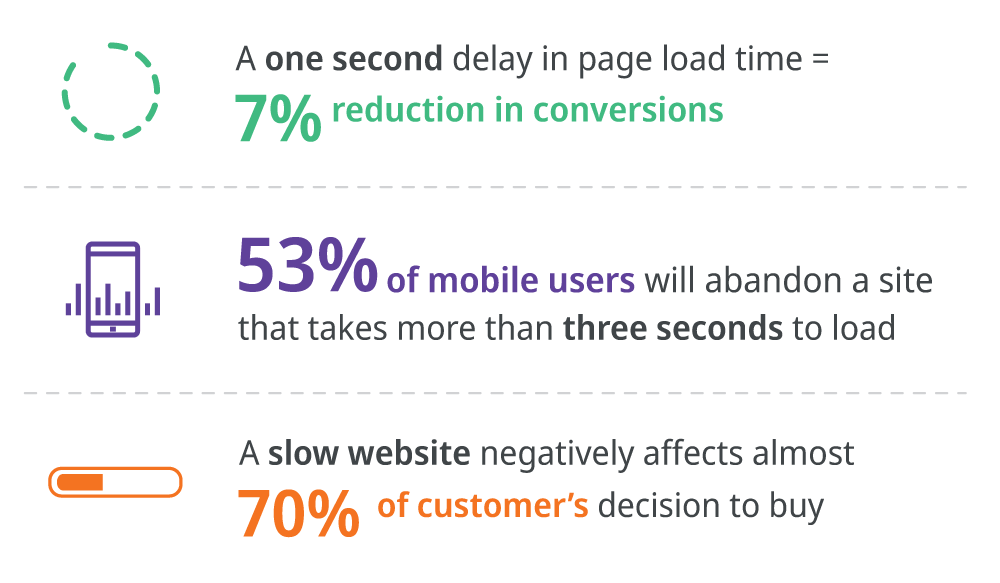 A velocidade também é importante no back-end. Por exemplo, no início de sua jornada na nuvem, muitos varejistas selecionaram a arquitetura monolítica para seu site de comércio eletrônico, a prática de projetar e desenvolver um aplicativo completo em uma única unidade (front-end, API, serviços, balanceador de carga, banco de dados etc.).
A velocidade também é importante no back-end. Por exemplo, no início de sua jornada na nuvem, muitos varejistas selecionaram a arquitetura monolítica para seu site de comércio eletrônico, a prática de projetar e desenvolver um aplicativo completo em uma única unidade (front-end, API, serviços, balanceador de carga, banco de dados etc.).
Esse modelo fazia sentido, pois oferecia todas as funcionalidades de comércio eletrônico de que os varejistas precisavam em uma unidade ou produto. Infelizmente, aplicativos monolíticos não são muito ágeis. Em vez disso, eles estão fortemente acoplados, o que significa que, se algo der errado com uma função específica, todo o aplicativo poderá travar, incorrendo em tempo de inatividade caro. Além disso, novos recursos são demorados e complicados de adicionar, afetando a escalabilidade.
Como resultado, muitos varejistas estão migrando para a arquitetura de microsserviços, uma coleção de arquivos executáveis separados que podem ser mantidos e substituídos de forma independente sem reimplantar todo o aplicativo.
Por exemplo, um aplicativo de comércio eletrônico terá funcionalidades como listagem de produtos, adição de produtos a carrinhos, check-out de um pedido e pagamento. Com os microsserviços, cada uma dessas funções é desenvolvida e implantada de forma independente e integrada por meio de um gateway de API para uma pilha de tecnologia totalmente modular e combinável.
Os varejistas podem modificar preços, produtos e workflows no momento sem interromper o negócio. Quando (e não se) o mercado mudar, o retalhista pode ajustar a sua infraestrutura em tempo real para garantir que permanece em sintonia com o comportamento do consumidor.
Uma arquitetura de microsserviços depende da integração de sistema e dados para conectar todas as partes móveis.
A tecnologia de plataforma como serviço (iPaaS) de integração empresarial, em particular, suporta a flexibilidade de uma pilha de tecnologia combinável, onde aplicativos legados são substituídos e/ou conectados com aplicativos baseados em nuvem.
Com fluxos de dados simplificados de sistemas de informações de varejo, a empresa se beneficia de análises precisas, essenciais na previsão de varejo para prever estoque e demanda. Essas conexões ágeis permitem que a empresa ajuste facilmente sua infraestrutura para alavancar novas inovações sem incorrer em tempo de inatividade para executar o trabalho.
A Digibee fez parceria com muitos varejistas de sucesso para implementar sistemas e integração de dados. Um bom exemplo é Payless, uma rede internacional de varejo de calçados self-service. Ao implementar o eiPaaS da Digibee, a empresa conseguiu integrar uma plataforma segura de comércio eletrônico em mais de 200 lojas em 15 países, em menos de 30 dias, sem tempo de inatividade.
Com o DigiBee, Payless otimizou sua agilidade, mantendo os negócios normais mesmo durante picos de vendas em eventos de alto volume, como a Black Friday.
Um futuro saudável depende da capacidade do varejista de oferecer experiências digitais incríveis aos clientes. Para alcançar esses resultados, a empresa deve adotar rapidamente as inovações à medida que elas surgem, ou corre o risco de ficar para trás.
Uma arquitetura componível ou de microsserviços desempenha um papel crítico nesses resultados, permitindo que a organização substitua facilmente qualquer componente por algo melhor. Com o suporte da tecnologia eiPaaS, os varejistas podem evoluir rapidamente seus negócios.
Embora esse recurso tenha sido crítico durante a pandemia, ele também protege os negócios de interrupções no futuro, permitindo que os varejistas acomodem o que está por vir. E há muito para acomodar. Enquanto algumas tendências já estão em andamento, outras estão chegando:
Hoje, as compras online são uma capacidade crítica para qualquer varejista, com sucesso dependendo da agilidade e resiliência do negócio diante da mudança. Os varejistas capazes de acompanhar e até prever o que vem a seguir serão os pioneiros, garantindo e aumentando sua participação no mercado.
A tecnologia empresarial iPaaS da Digibee permite uma infraestrutura combinável baseada em nuvem, nivelando o campo de atuação para que varejistas de todos os tamanhos possam oferecer uma experiência de compra moderna enquanto amplificam sua voz e marca na nuvem. Contacte-nos para aprender mais ou agende uma demonstração.
– Um atraso de um segundo no tempo de carregamento da página = a Redução de 7% nas conversões
– 53% de usuários móveis vai abandonar um site que leva mais de três segundos para carregar
– Um site lento afeta negativamente a decisão de compra por quase 70% de clientes

Discussão sobre os medos associados à mudança do local para a nuvem, bem como os avanços tecnológicos que tornam isso mais fácil do que nunca.

Se aprendemos algo nos últimos anos, é que adaptar-se rapidamente às mudanças é essencial para a sobrevivência dos negócios. A base sobre a qual construímos nossa infraestrutura de TI deve ser capaz de operar de forma ágil, eficiente e segura para garantir a continuidade da empresa.
Tam Ayers, CTO, compartilha sua previsão para os próximos anos:
A arquitetura composable nos oferece a flexibilidade necessária para enfrentar as adversidades — conhecidas e desconhecidas — que estão por vir. Em vez de resistir às mudanças e investir para manter o status quo, a composabilidade nos permite abraçar as mudanças, crescer e prosperar, independentemente do que o mundo nos impõe.
Algumas empresas já estão avançadas, com a arquitetura composable como um padrão consolidado. Outras estão apenas começando sua jornada. Em qual estágio sua organização está?
No artigo As 3 principais previsões tecnológicas da Digibee para 2023, destaquei o papel importante que a infraestrutura composable desempenhará para ajudar as empresas a gerenciar mudanças de curto e longo prazo.
Acredito que será um diferencial crucial nos negócios, ajudando as empresas a se protegerem contra crises econômicas inesperadas, conflitos globais, pandemias, crises energéticas e outras interrupções.
“Em tempos turbulentos, os princípios do negócio composable ajudam as organizações a dominarem mudanças aceleradas, essenciais para resiliência e crescimento. Sem isso, as empresas modernas correm o risco de perder momentum no mercado e a lealdade dos clientes.”
David Groombridge,
Vice-presidente de pesquisa, Gartner
Empresas que adotam uma arquitetura composable ou de microsserviços estão destinadas a vencer. Na verdade, analistas da Gartner preveem que essas empresas superarão a concorrência em 80% na velocidade de implementação de novos recursos.
Outras vantagens incluem:
Mesmo com tecnologias de ponta e algoritmos de IA precisos, prever o futuro nunca será uma ciência exata. Apesar da necessidade de analisar e prever, é vital estar preparado para se adaptar rapidamente a mudanças inesperadas.
Com a composabilidade, a empresa adota um modelo de TI modular, permitindo substituir facilmente componentes individuais por tecnologias mais adequadas às condições de mercado.
Por outro lado, empresas que utilizam arquiteturas monolíticas, em que os componentes estão fortemente interligados, enfrentam dificuldades para implementar mudanças sem impactar todo o ecossistema.
Por exemplo, devido a problemas globais na cadeia de suprimentos, um varejista deve ajustar continuamente sua loja virtual para refletir níveis de estoque flutuantes. Se não puder fazer essas alterações em tempo real, a experiência do cliente se deteriora, e o negócio pode falhar.
A infraestrutura composable liberta as organizações para experimentarem inovações e identificarem o que funciona melhor. A Gartner prevê que 20% dos CEOs do Global 2000 relatarão um aumento do apetite por riscos e maior resiliência, atribuído ao redesenho modular do negócio.
Sem depender de stacks monolíticos, as empresas se tornam ágeis, desafiando crenças enraizadas e explorando cenários que melhor atendem às suas necessidades. Em vez de investir grandes recursos apenas para manter as operações, as equipes de TI e Desenvolvimento podem focar em inovação e no futuro.
A tecnologia deixa de ser um limitador para o negócio, que agora está capacitado a explorar seu potencial e traçar seu próprio caminho, independentemente dos desafios futuros.
A composabilidade reduz a dependência de um grupo restrito de técnicos e desenvolvedores com experiência ampla necessária para gerenciar um ecossistema monolítico. Esse nível de conhecimento técnico deixa de ser um gargalo para a implementação de mudanças. Em vez disso, todos passam a contribuir com inovações, permitindo o aproveitamento de recursos menos experientes (e mais acessíveis) para realizar o trabalho.
Como resultado, o TI se tornará mais centralizado. Uma maior responsabilidade ficará nas áreas de negócio, onde técnicos e desenvolvedores serão contratados e alocados para atender a demandas específicas de cada unidade.
Embora os gastos com TI estejam previstos para crescer, o investimento será direcionado para aumentar a eficiência, simplificar processos e melhorar a produtividade dos funcionários. A composabilidade apoia esses resultados, integrando capacidades digitais em todas as operações da empresa.
Os clientes da Digibee utilizam nossa plataforma iPaaS low-code para apoiar suas arquiteturas composable, conectando sistemas modernos a tecnologias legadas. Nossa solução inclui componentes reutilizáveis, como cápsulas da Digibee, que aceleram o desenvolvimento e a implementação de integrações, impulsionando a inovação.
Se você está interessado em saber como a Digibee pode ajudar sua organização a evoluir para um ambiente de TI modular, teremos prazer em mostrar como. Agende uma demonstração com nosso time de especialistas e veja por si próprio.

A solução de integração certa pode trazer grandes benefícios para o departamento de TI da sua organização. Inclusive, é o foco da maioria dos artigos sobre os benefícios da integração de dados: redução de custos, aumento da eficiência dos desenvolvedores e menor dependência de especialistas em TI, cada vez mais difíceis de encontrar. Mas e o restante da sua empresa?
Se o seu departamento de TI está entre os poucos que não enfrentam dificuldades com escassez de especialistas ou mesmo com aumento de custos, você pode achar que não precisa de uma plataforma de integração. Não caia nessa armadilha. Existem diversas maneiras de outros departamentos se beneficiarem também com a adoção de uma plataforma de integração.
>> Agende uma demonstração personalizada com nossa equipe de especialistas e veja como o iPaaS da Digibee trará eficiência ao seu negócio.

Com uma solução iPaaS empresarial, as integrações são concluídas mais rapidamente do que quando os desenvolvedores precisam criar conexões ponto a ponto manualmente. Reduzir o tempo gasto na construção de integrações significa que os sistemas estão conectados e os dados trocados antes do previsto. O resultado? Sua equipe pode acelerar a transformação digital e reduzir o tempo de lançamento de novos produtos ou serviços.
Um tempo de mercado reduzido significa mais tempo para gerar receita. E mais receita beneficia toda a sua organização. Analistas da Forrester estimam um aumento de US$ 1.3 milhão em receita ao longo de três anos devido ao tempo de mercado mais rápido com o iPaaS da Digibee.
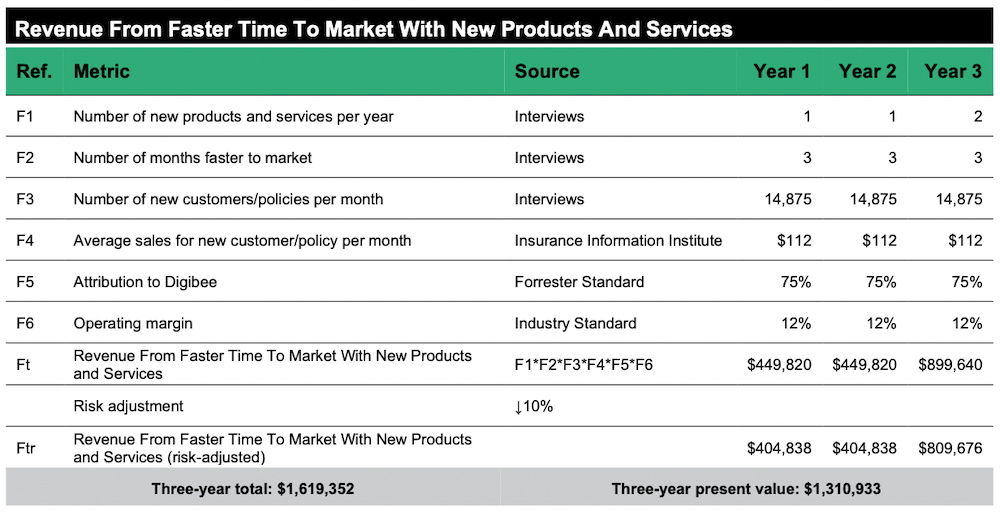
Fonte: The Total Economic Impact™ da plataforma de integração empresarial como serviço (iPaaS) da Digibee, um estudo encomendado pela Forrester Consulting em nome da Digibee
Um iPaaS também melhora a confiabilidade do desempenho dos sistemas e aplicações. Como a plataforma low-code da Digibee reduz o risco de erros humanos e inclui monitoramento integrado, as interrupções são mínimas, e a identificação e resolução de problemas são rápidas e fáceis.
A custo da inatividade está aumentando continuamente, e os atrasos no acesso aos dados em tempo real podem impactar negativamente a tomada de decisões. O iPaaS certo pode ajudar a melhorar a confiabilidade e a segurança dos seus sistemas, independentemente do tamanho ou escala.
Quando o Weir Group precisou integrar sistemas usados por 11,500 funcionários em 50 países, recorreu à Digibee em busca de uma solução. A Digibee conectou seus sistemas críticos de negócios aos sistemas corporativos existentes, como ERP e SAP, otimizando o fluxo de dados, implementando protocolos rígidos de segurança e adicionando monitoramento proativo para minimizar as interrupções. |
O ditado “o cliente tem sempre razão” nunca foi tão verdadeiro quanto é hoje. As expectativas dos consumidores em relação às marcas com as quais fazem negócios estão em alta, e melhorar a experiência do cliente foi a prioridade máxima (por uma margem significativa) no Relatório State of Customer Care da McKinsey.
Enquanto suas equipes internas podem não ter escolha a não ser lidar com processos de negócios lentos e ineficientes, seus clientes não vão aceitar uma experiência que não atenda às suas expectativas. Outro benefício do uso de integração é que ela pode capacitar sua empresa a oferecer as experiências que seus clientes desejam – com novas tecnologias e eficiência maximizada.
A GJP Hotéis e Resorts, uma das principais cadeias de hospitalidade do Brasil, enfrentava um aumento na rotatividade de clientes devido à frustração dos hóspedes com os processos demorados de check-in e check-out. A empresa fez uma parceria com a Digibee para digitalizar fluxos de trabalho e integrar seu Sistema de Gestão de Propriedades com tecnologia de autoatendimento. Os resultados foram quase imediatos: |
Não se trata apenas de TI. Stakeholders de departamentos em todos os níveis da sua organização podem perceber os benefícios empresariais da integração. Mas a comunicação aberta sobre as prioridades e metas de integração é fundamental.
Quando realizamos uma pesquisa com mais de 1,000 profissionais de TI empresarial no início de 2022 para nosso State of Enterprise Integration, observamos uma desconexão significativa entre os diferentes participantes quando questionados sobre quem é responsável pela integração empresarial. O C-suite, especialistas em TI, equipes de produtos e desenvolvedores cidadãos podem todos se beneficiar da solução de integração certa – mas somente se trabalharem em cooperação em vez de competição.
Se sua organização está procurando uma solução iPaaS para ajudar a modernizar a infraestrutura legada, implementar uma estratégia de transformação digital ou apenas aumentar a eficiência operacional, a Digibee pode ajudar.
Nosso iPaaS low-code facilita para especialistas em TI e desenvolvedores criarem, implementarem e manterem integrações para apoiar suas metas empresariais. E quando você trabalha com a Digibee, não está apenas contratando um provedor de serviços – você ganha um parceiro, ao seu lado em cada etapa do processo, totalmente comprometido com o seu sucesso.
Baixe uma cópia do TEI do eiPda Digibee para conhecer todos os detalhes sobre os benefícios de integração de dados que sua empresa pode alcançar. Ou agende uma demonstração personalizada para ver tudo o que a nossa solução pode fazer pelo seu negócio.
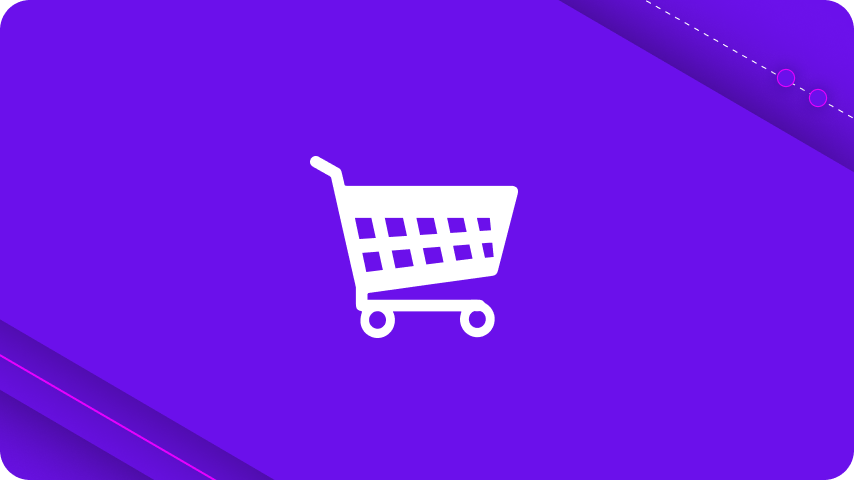
A plataforma de integração da Digibee ajuda a rede internacional de supermercados a aumentar as vendas online em quase US$ 2 milhões mensais.

A Digibee constrói uma infraestrutura de integração segura para conectar uma plataforma de bolsa de valores com instituições financeiras e clientes.
X